Beyond Frontiers Tulip Integrated Amplifier
| The Best of Both Worlds? |
|
|
|
August 2011 |
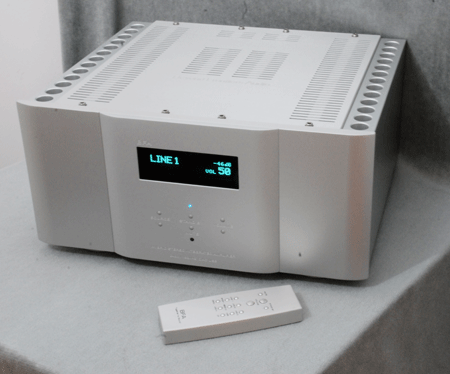
Beyond Frontiers Audio (BFA) is a Serbian-based manufacturer of high-end, hybrid-based audio components founded in 2009. Although BFA is not well known, its head designer, Zdenko Zivkovic, was director of design at Magnum Dynalab and before that was a senior designer at Sonic Frontiers (now defunct)—hence the Beyond Frontiers moniker. Who can forget the remarkable impact Sonic Frontiers had on the industry back in the ’90s? I was especially fond of their SFD Mk II DAC (of which I was a proud owner). Unfortunately, Sonic Frontiers was bought out in the fall of ’98 by Paradigm, which chose to capitalize on the Sonic Frontiers home theater brand “Anthem” and drop the tube line altogether.
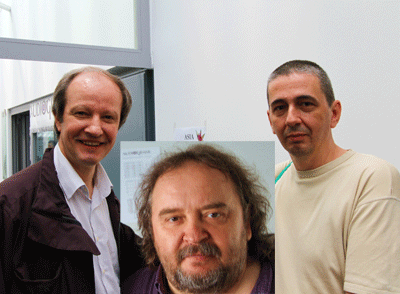
Today, nearly 15-years after closing their doors, Zivkovic (center), partner Andria Sabolcki (digital designer, right), and financial backer Bosko Pjescic (left), officially launched their first product in the Beyond Frontiers lineup: an understated 200-watt, tube and solid-state integrated amplifier named the Tulip. (I’m informed that Glenn Dolick, who was also a senior designer at Sonic Frontiers, has recently joined the BFA team to handle international marketing).
I met Bosko Pjescic at the Rocky Mountain Audio Fest and expressed an interest in reviewing the BFA Tulip. Some weeks later, a BFA Tulip arrived in a heavy wooden crate directly from the BFA factory in Serbia. When the shipper informed me the shipping weight was 150 pounds, I thought Pjescic had mistakenly sent me loudspeakers. But after removing more than a dozen screws, I got my first glimpse of the big, bulky Tulip neatly nestled in a web of heavy foam padding. It reminded me of a Sansui integrated amplifier (AU-2000?) I owned in the ’70s.
At 200 watts per channel and weighing nearly 110 pounds, the BFA Tulip makes a definite physical statement and although compactly built, its size belies its flowery moniker.
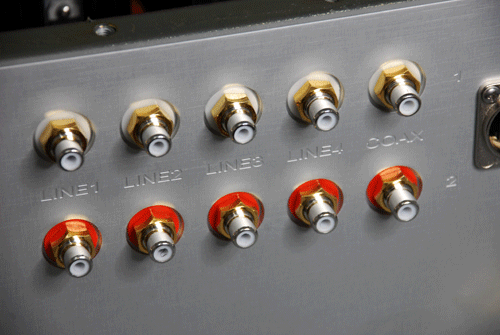
The thick aerospace aluminum chassis (that comes in black or silver) gives the Tulip a very solid feel. The front of the Tulip has a rather understated look. Centered on the faceplate is a smartly designed, large VFD display and directly below that is an on/standby LED. Below it are three pairs of small buttons which control input, mute, standby and volume. The unit’s remote offers the same controls. On the rear are six pairs of Cardas rhodium RCA jacks, four for analogue inputs, two for SP/DIF digital inputs, and a single Neutrik USB port. You can connect your iPod directly without having to use a docking station (which I regret never getting the chance to fully explore due to fact I do not own an iPod or listen via my PC…yet). In addition, the Tulip has a 24-bit/192kHz hi-resolution DAC (Burr Brown SRC4192 receiver and 1794A DAC) designed by Andria Sabolcki.
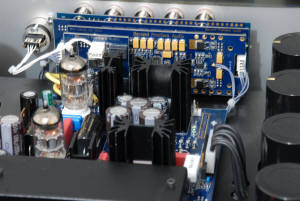 BFA claims the Tulip is the world’s first amplifier with a 100% tube gain stage (patent-pending), designed by Andria Sabolcki without any type of feedback. Basically, the voltage is amplified directly from a single Tesla ECC83S vacuum tube, with the audio signal referenced to virtual ground by an E88CC. The output stage consists of multiple bipolar output transistors. “Audio signal remains untouched, preserving the sound quality and dynamic,” says Zivkovic. In addition, the Tulip uses a patent-pending relay volume control designed by Andria Sabolcki using self-latching Takamishawa relays. “The goal was to achieve no current in the relays and produce zero clicking (noise) at the speakers after desired volume is met,” says Sabolcki. The Tulip’s internal parts are all first class: Mundorf silver/gold oil capacitors; Sanken output transistors; WBT binding posts and Mundorf and Kimber silver wire. The sturdy all-aluminum remote was designed in-house by Sabolcki.
BFA claims the Tulip is the world’s first amplifier with a 100% tube gain stage (patent-pending), designed by Andria Sabolcki without any type of feedback. Basically, the voltage is amplified directly from a single Tesla ECC83S vacuum tube, with the audio signal referenced to virtual ground by an E88CC. The output stage consists of multiple bipolar output transistors. “Audio signal remains untouched, preserving the sound quality and dynamic,” says Zivkovic. In addition, the Tulip uses a patent-pending relay volume control designed by Andria Sabolcki using self-latching Takamishawa relays. “The goal was to achieve no current in the relays and produce zero clicking (noise) at the speakers after desired volume is met,” says Sabolcki. The Tulip’s internal parts are all first class: Mundorf silver/gold oil capacitors; Sanken output transistors; WBT binding posts and Mundorf and Kimber silver wire. The sturdy all-aluminum remote was designed in-house by Sabolcki.
SYSTEM
My downstairs rig is built around a Behold Gentile Integrated amplifier ($18,000). Due to its enormous flexibility the Gentile has served as the perfect reviewing tool. In addition to being an integrated design with a modest 40-watts per side, it has a built in DAC — like the Tulip. Unlike the Tulip however, the Gentile sports multiple digital inputs and analogue outputs/inputs, can be used as a preamp and comes with very sophisticated room-correction software. The Gentile seemed to be the best candidate for comparison with the BFA Tulip since it has a nearly identical asking price.
Loudspeakers ranged from the wonderful sounding TIDAL Piano Cera of Germany ($26,000), the French Tanagra Audio Lotus monitors ($5500), and lastly, the affordable reference-caliber Revolver Music 3 monitors from England. A few CD players were on hand: the Italian North Star Designs model 192 DAC/transport combo, the PS Audio Perfect Wave and lastly the Operatta CD100A ($5500).
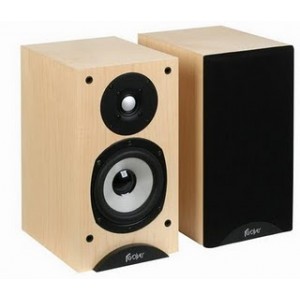

Yes, the BFA Tulip’s rated power output is nearly four times the Gentile’s. Yes, some sonic differences are going to be dependent on loudspeaker sensitivity. The Revolver Music 3 monitors have 89 dB sensitivity and, by and large, are midrange marvels. I’ve been smitten with the openness and midrange beauty of this English transducer—especially when you consider its asking price of $1300! But as good as the Music 3 sounded with the Behold Gentile, I was astonished at what I heard when I strapped them to the BFA Tulip.
SONIC IMPRESSIONS
At first blush, the Tulip produced—almost shockingly—a deeply layered, rich and textured sound. Rhythmic timing and tempo seemed to be ever-so slightly “slow-motion,” giving instruments more buoyancy, dynamic swing, and a greater sense of suspense. High frequency energy took on a slightly different hue: a burnished glow surrounded cymbals and other percussive instruments.
Human voices, particularly the enunciation of words, took on a more realistic character as if the Tulip dug deeper into the soul of each singer. A perfect illustration would be the late Luther Vandross’ recording “Live at Radio City Music Hall 2003.” This live date has to be one of his finest recordings, and that’s saying a lot considering his body of work and how beloved he was (and still is). Hearing him on the BFA Tulip almost brought me to tears. The conviction in his velvety vocal phrasings came through the BFA Tulip in ways I had not experienced with the Gentile. This made me mourn once more his untimely passing in the summer of 2005.
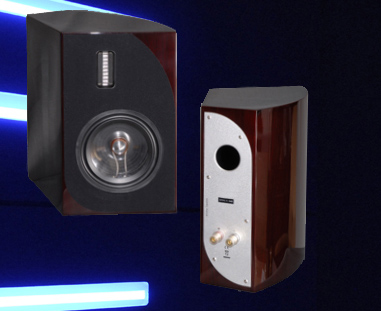
The Lotus monitors from Tanagra Audio of France (above photo) did not improve on the midrange magic whatsoever (kudos to the Music 3s), but bass, clarity, and image specificity did improve markedly. The Lotus boasts a ribbon tweeter and a curved enclosure that allows as little cabinet noise as possible. The 90db sensitivity Lotus goes deeper, yet has a noticeably quicker first step than the Music 3s, and they possess an unlimited wealth of high frequency detail (compliments of that ribbon tweeter, I bet). The BFA Tulip surpassed my expectations, it deftly disarmed my critical reviewer thought processes by quenching my music lover’s thirst!
The Tulip provided all the goods, no matter the monitor or source. If you’ve excellent, but relatively inexpensive loudspeakers, you might be surprised how good they sound when strapped to the Tulip. This amp boasts a taut and robust bottom end, oodles of harmonic richness and a level of dimensionality that I found myself longing for whenever I switched back to the Gentile.
There’s a consensus among tube-loving audiophiles that tubes are better at reproducing rich harmonics, the truth of timbre, and more three-dimensional images. Solid-state owners are convinced that the loss of bass control, prowess, and dynamics is too much to give up. The Tulip’s a hybrid powerhouse that is designed to keep the best that solid-state has to offer while capturing the soul which only tubes are said to provide. This is a Class A/B amplifier in a world where Class D has become increasingly popular. It is powerful, yet the Tulip can be submissive when it needs to be. The sound is never pushy nor in your face. On mini-monitors, the BFA Tulip behaved like a gentleman. Its command, especially on the mid-bass was always taut, authoritative and, most importantly, thoroughly musical.
UPPING THE ANTE
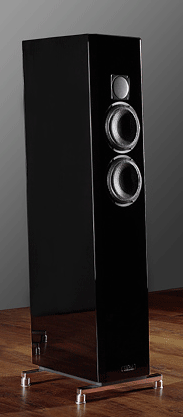 The arrival of the TIDAL Piano Cera loudspeakers from Germany couldn’t have come at a more appropriate time. Equipped with dual 7″ mid/bass drivers and a single 1″ ceramic tweeter, I’ve been particularly fond of TIDAL ever since I first heard it some years back. At $26,000, they’re fairly high priced, but they’re also among the finest loudspeakers I’ve heard at their size and asking price (review in the works). They’re a monitor-styled loudspeaker based on their closely grouped driver array: except their well designed and inert cabinet extends right down to the floor. This allows for far greater bass extension while keeping images tight and well-focused. Once I got these puppies out of their huge shipping crates, strapped and ready to roll, I could easily hear the jump-factor in quality and musicality. The TIDAL Piano Cera/BFA Tulip combination has a synergy that I think would impress anyone looking to invest a significant amount in a system. This impression, I might add, came at first blush with hardly any burn-in.
The arrival of the TIDAL Piano Cera loudspeakers from Germany couldn’t have come at a more appropriate time. Equipped with dual 7″ mid/bass drivers and a single 1″ ceramic tweeter, I’ve been particularly fond of TIDAL ever since I first heard it some years back. At $26,000, they’re fairly high priced, but they’re also among the finest loudspeakers I’ve heard at their size and asking price (review in the works). They’re a monitor-styled loudspeaker based on their closely grouped driver array: except their well designed and inert cabinet extends right down to the floor. This allows for far greater bass extension while keeping images tight and well-focused. Once I got these puppies out of their huge shipping crates, strapped and ready to roll, I could easily hear the jump-factor in quality and musicality. The TIDAL Piano Cera/BFA Tulip combination has a synergy that I think would impress anyone looking to invest a significant amount in a system. This impression, I might add, came at first blush with hardly any burn-in.
Switching from the BFA Tulip back to the Behold Gentile took the sound from intimate and inviting to amazingly clear and see-through. The sound of the Behold Gentile keeps your attention, while the sound of the BFA Tulip pulls you right into the music. The Gentile has a see-through quality that reminds me of a star-filled night sky in the Arizona desert, where you feel as if you can see forever. The BFA Tulip, on the other hand, reminds me of an afternoon sky (right here in northern New Jersey) where the sun’s peeking out at you behind a billowing cloud formation. Each elicits different emotions. I always marvel at the vastness of the universe when gazing up at the night sky. It’s a most humbling feeling because it reminds me of how insignificant we mere mortals are. But whenever I see the sun peeking out behind a huge cloud burst, I am reminded of what my grandfather would say to me as a child, “God’s smiling down on ya son!” And that’s the feeling that comes over me while listening to the Tulip—except I hope it’s Sarah, Ella, Miles, ‘Trane, and Dizzy who are smiling down on me.
Unlike the Behold Gentile, which is as versatile as a Swiss army knife, the BFA Tulip’s single most outstanding achievement resides in its basic design: it’s a hybrid. Its designer brilliantly combined the “proper harmonics” that make tube lovers rejoice with “dynamics and ultimate control” that solid-state lovers treasure. The BFA Tulip has that rare, unique ability to behave like a solid-state amplifier while maintaining a sense of intimacy and delicacy that I’ve always admired about tubes. Of the other hybrids that come to mind, that are also excellent sounding, would be the $24,000 Lamm Audio 1.1 and the $90,000 Tenor Audio amplifiers. Hence, this level of build quality and performance doesn’t come cheap.
TAKING THE SHOW ON THE ROAD
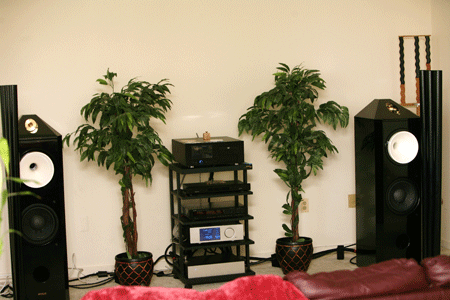
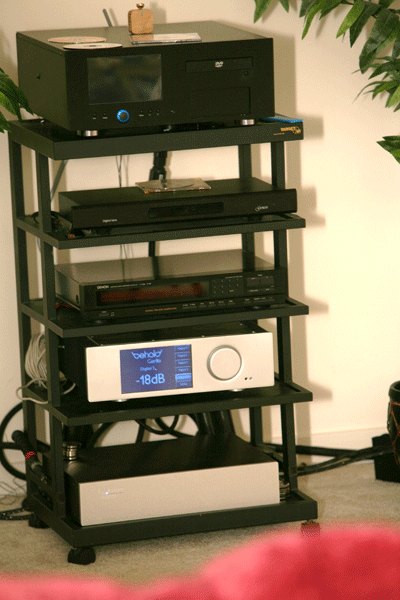 Convinced the Beyond Frontiers Tulip had elevated my musical enjoyment beyond what I thought possible from an integrated design, I took it on the road for further observations. Dennis Parham, who is my neighbor and trusted friend has a system that’s similar to mine: Behold Gentile, Sunny Technology H3W12 horn loudspeakers ($20,000), Bybee wire throughout, and the Nova Physics Memory player. His system however has a plethora of tweaks that include the Stein Harmonizers, Acoustic Resonators, PS Audio Power Plant AC regenerator and a pair of Shakti Hallographs. In short, I value his system as a reference away from home. To convince Dennis to allow me to audition the Tulip’s performance in his system, I first invited him over to hear it in my system. It turned out I didn’t have to ask the question before he gushed, “I would love to hear this in my system!!”
Convinced the Beyond Frontiers Tulip had elevated my musical enjoyment beyond what I thought possible from an integrated design, I took it on the road for further observations. Dennis Parham, who is my neighbor and trusted friend has a system that’s similar to mine: Behold Gentile, Sunny Technology H3W12 horn loudspeakers ($20,000), Bybee wire throughout, and the Nova Physics Memory player. His system however has a plethora of tweaks that include the Stein Harmonizers, Acoustic Resonators, PS Audio Power Plant AC regenerator and a pair of Shakti Hallographs. In short, I value his system as a reference away from home. To convince Dennis to allow me to audition the Tulip’s performance in his system, I first invited him over to hear it in my system. It turned out I didn’t have to ask the question before he gushed, “I would love to hear this in my system!!”
At Dennis’s house, we hooked up the Tulip using its internal DAC. We selected some of our favorite tracks from Nova Physics’ solid-state drive and started listening. Harvest Moon, from Cassandra Wilson’s “New Moon Daughter” CD, is a long-time reference that captures Cassandra’s raspy, soulful voice at her most entrancing. As expected, the soundstage grew both in width and depth beyond the physical location of the loudspeakers. This, in turn, offered a bigger and clearer window, giving greater exposure to Cassandra and her bandmates. The bass, for example gained a certain “resonant” characteristic: a palpability that wasn’t as obvious before the installation of the Tulip. Dennis, an intense listener, gave me a nod of appreciation like he was hearing the same improvements. What was most apparent after extended listening was that this system wanted a powerful amplifier with soul, and although it had sounded terrific with the Behold, the Tulip seemed to take it over the top.
There was a combination of sustained weight mixed in with sheer power and a helping dose of harmonic richness. Music, no matter the age or artist, took on a greater sense of rhythmic swing while never appearing forced. The sound had a sense of ease and finesse that was intoxicating. In the end, I left without the Tulip to give Dennis time to audition in private. I think his system took a huge leap in the right direction. Dennis apparently agreed because in a few days he wanted to purchase the Tulip.
The Beyond Frontiers Tulip integrated amplifier, in my opinion, will set a new benchmark for what is possible at its $18,000 asking price. I have more expensive separates that could not do what I heard this integrated amplifier do with ease. Out of the box, it handily outperforms my favorite integrated amplifier (Behold Gentile) in the areas of harmonic richness, dimensionality, and musicality. The Behold Gentile, which I still regard as the most versatile amplifier available, provides what I’d call a more neutral sound.
I think the Tulip would be even more attractive were it equipped with XLR inputs and perhaps a set of pre-out inputs. As it stands now, my only caveat is that it doesn’t provide nearly the flexibility it could and should. However, in terms of sheer sonic capabilities, I have to admit that I am smitten, and think you will be too. Highly recommended!

![]()
clement perry
Post script- I am informed that the BFA Tulip now has preamp out RCAs a standard production.
Specifications:
– Gold plated PCB
Tubes: JJ Tesla 1x ECC83S and 1x E88CC Gold pins, cryogenically treated
Silver-gold-oil capacitors (2x) and electrolytic 4 x 47000uF Mundorf
Power 200 watts per channel
Dual-mono, current output amplifier with Sanken bipolar transistors
– 100% tube gain with servo control of operation
– pure silver Mundorf and Kimber wire PTFE insulation
– output terminals WBT and input Cardas, Neutrik USB
– built-in 24bit/192kHz resampling DAC (all audio data always plays on 24bit/192kHz)
– accepts both COAX(SPDIF) and USB digital signal transport
– click-less (in sound path) Relay Volume Control – Patent Pending
– vfd display Noritake – Japan
– full remote control, in house patented remote protocol, 100% stable operation
– toroidal transformer 1600W
– inputs: 4 x LINE, 2 x COAX and 1 x USB
– output: 2 x 200W/8ohm, 2 x 400W/4ohm, capable to drive speakers down to 2ohm
Price: $18,000 USA
Contact:BEYOND FRONTIERS AUDIO
Rade Smiljanov 5
21000 Novi Sad
SERBIA
www.beyondfrontiersaudio.com
www.bfa.rs
Phone/fax.: +381 / 11 / 263 20 21
cell.: +381 / 63 / 326980
![]()
Don’t forget to bookmark us! (CTRL-SHFT-D)
Stereo Times Masthead
Publisher/Founder
Clement Perry
Editor
Dave Thomas
Senior Editors
Frank Alles, Mike Girardi, Russell Lichter, Terry London, Moreno Mitchell, Paul Szabady, Bill Wells, Mike Wright, and Stephen Yan,
Current Contributors
David Abramson, Tim Barrall, Dave Allison, Ron Cook, Lewis Dardick, John Hoffman, Dan Secula, Don Shaulis, Greg Simmons, Eric Teh, Greg Voth, Richard Willie, Ed Van Winkle, Rob Dockery, Richard Doron, and Daveed Turek
Site Management Clement Perry
Ad Designer: Martin Perry





Be the first to comment on: Beyond Frontiers Tulip Integrated Amplifier